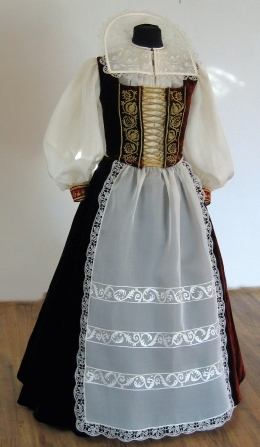Reconstruction design after a contemporary portrait
Magdaléna M. Zubercová, Jana Zaujecová
Between 2006 and 2007, a team of experts headed by clothing historian M. M. Zubercová made a reconstruction of clothing Elizabeth Báthory used to wear. The portrait painting the experts used for the work had, most likely, been made after her death. The portrait depicts a woman in a very simple dress which is, one must say, too humble for one of the wealthiest ladies of the Hungarian Empire, she certainly was. The team of experts made the reconstruction of clothing, depicted in the contemporary literature as “the Hungarian” or “the Hungarian-like“ dress.
They reconstructed the dress for 6 months. From 15 August 2008, the Trenčín Museum displays the dress at the Čachtice Castle.
Experts supported the work with historical data allowing makers to employ original contemporary techniques used for lace making, embroidery, stitching and sewing, all exclusively from natural materials. They used silk, linen, cotton (a linen replacement) and wool fabrics and yarns. Naturally, now available technologies and materials restricted their work with an old theme. All garments are hand-made.
Underclothing is heavily folded around neck and wrists.
Hoop skirt reconstruction required natural-coloured unbleached linen and copper hoops. Two waist-wrapped underskirts were put on the hoop skirt.
Top shirt is the first visible garment of her clothing. It is a hip-long piece of clothing with wrist-folded wide and long sleeves, heavily folded around neck. Cuffs show embroidery and metal thread bobbin-lace trimming.
Traditional stitches decorate the whole length of a collar. Leaves and flowers on a waved stem make the ornamental structure. 30 silk bobbin lace points decorate the edge of the collar.
Bearing the heavy skirt, the bodice is fastened to it in the waistline. The bodice is laced through 14 pairs of hand-made brass hooks and metal thread decorated. A wavy line is surrounded by the renaissance motifs of pomegranates, apples, flowers, buds, leaves and tendrils.
The apron is decorated with 42 points of fine bobbin lace and three embedded full-stitched strips. The apron is waist-folded.
Experts could not read the bonnet ornaments on the portrait, so they made their own interpretation and decided not to decorate the bonnet at all. The original bonnet, however, could have been richly decorated.
